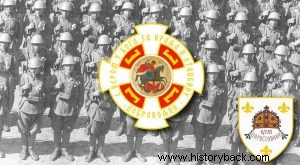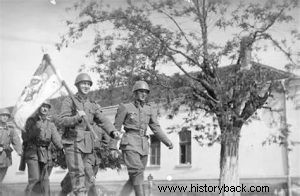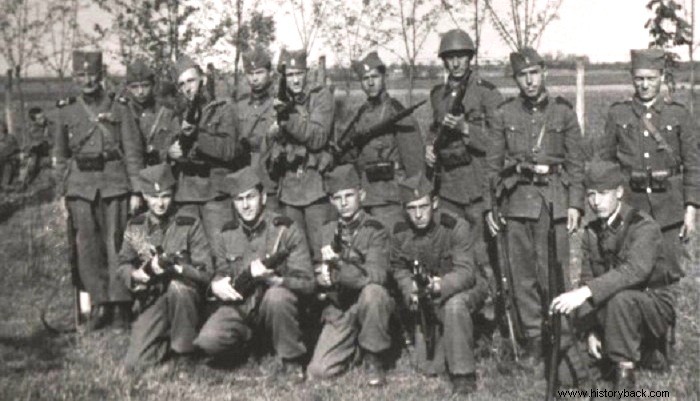
Yugoslavia, for a number of reasons, offered little resistance to the German invasion in April 1941. The main reason was considered, from the Serbian side, the defection of the Croats. In fact everything went wrong, and above all, the plan for the concentration of the Yugoslav army was wrong. After all, it was not only the Croats who wished for the victory of the Germans... There were also Serbs who desired the same.
The "Serbian Volunteer Corps" (SVR) had its origins in the ZBOR, the Yugoslav National Movement, a National Socialist ideology organization founded in 1935 and lavishly funded by Hitler's Germany. It was headed by Dimitri Liotits who was also King Alexander's minister until the assassination of the latter in 1934. Immediately afterwards he founded ZBOR.
Organization
In July 1941, with Yugoslavia under occupation and with General Nedić's government of collaborators – in theory – at the helm and the nationalist Chetniks and communists having gone into insurgency – the latter following the German invasion of the USSR – the Germans sought Serbian allies and … they found.
On September 16, 1941 234 members of the ZBOR led by Liotić formed a Serbian militia unit to serve against the Germans. The colonel, at the time, Konstantin "Kosta" Musiski, who helped the Germans during the German invasion of his homeland, was put in charge!
The next day it was decided to form a much larger regimental force of 12 companies, each with 120-150 men. Many volunteers were members of ZBOR but many more were refugees from the now independent Croatia. The volunteers received, initially, uniforms of the Yugoslav army. Later they also received Italian uniforms. Their helmets were Italian and Czechoslovakian. Their emblem was a cross in the colors of the Yugoslav flag with Saint George in the center and their motto was the phrase:"With faith in God, for the king and the country". The volunteers were armed with German, Italian and Yugoslav weapons.
Armed action
The corps saw action on the very first day of its formation, September 17, 1941, when two of its members were killed in a clash with communist guerrillas. In November of the same year the corps, together with the Serbian State Guard (the army the Germans allowed the Nedić government to have) and Chetnik units, formed the "Sumantia" Corps which participated in the offensive against the communist insurgents in the area of Uzice, under the German 113th Infantry Division. The operation was conducted between November 25 and 29 but the rebels escaped.
After the communists the Germans attacked the Chetniks but failed to capture their leader Draza Mihajlovic. Mihajlovic escaped after being informed by the leader of the FTA Musiski, who was arrested and replaced by Brigadier General Kukic. However, with the intervention of Nedić, Musicksi returned to the administration. In the meantime, the FTA had come to number, at the beginning of 1942, about 3,700 men included in four complete and one under formation battalions. The FTA took the lead in the conflicts with Tito's partisans in 1942 and in fact in almost all cases defeated them.
In 1943 the FTA fought both the partisans and the Chetniks. The Germans, however, captured Pavle Djurisic, a leading member of the Chetniks, who in order to save his life collaborated with the enemies forming units of volunteers who joined the FTA which now reached the strength of a brigade. Djurisic even took over as deputy commander of the FTA with Musiski as commander.
In the meantime, however, the partisans had also strengthened and now had the organization and strength of a real army. For this reason, following the Hitler-Neditz agreement, it was decided to strengthen the FTA. Finally, the FTA reached the number of almost 9,900 men included in five regiments. He fought the partisans in 1944, but due to the turn of the war the FTA began to disintegrate with a number of his men fleeing to the Chetniks.
Partisans and Soviets
When the Soviet Army invaded Yugoslavia he joined the partisans. It is worth noting that the FTA rescued the Chetnik leader Draza Mihailovic from the Partisans in September 1944. However, on 9 September the FTA and the now united Chetniks were soundly defeated by the Partisans. The remnants of the FTA, however, continued to fight under German command.
After new defeats the Germans integrated the FTA into the Waffen SS and ordered the evacuation of his men. The FTA men were transferred to Slovenia and then further north. The FTA, with the addition of other survivors, mainly Slovenian National Socialists and Chetniks, once again numbered around 8,000 men.
The FTA fought in Slovenia against the partisans, in fact, at first, successfully. However, the FTA had to face another enemy, the "allied" Croats, who were responsible for many executions of its members - the FTA men were Serbian nationalists, at least according to the Croats.
The FTA participated with great success and the fanaticism of despair in anti-partisan clashes throughout the winter of 1944-45, despite siding with the SS. The last success of the FTA was in March 1945 but it no longer had any practical impact. In the last serious clashes, in April 1945, the FTA fought alongside Germans, Slovenian Nazis, Chetniks and Russian anti-communists against Tito. On March 27, Musiski was replaced by General Damjanovic, who was also the last commander of the FTA.
Fatal ending
The FTA in turn joined the Chetnik "army" (Yugoslav Home Army) , under Draza Mihailovic. On April 20, 1945, the Axis forces attacked the 4th Partisan Army in the area of Rijeka (Croatia). But the attack failed and three days later the Axis forces were almost encircled. Some parts of the FTA managed to escape, ended up in Ljubljana and headed for Austria. The rest retreated to Italy. The divisions that passed through Italy – about 2,500 to 3,000 men – were handed over to the British.
Those moving towards Austria were also handed over to the British who, a few days later, handed them over to the Partisans who massacred them – at least 2,400 members of the FTA were killed, along with around 10,000 Slovenian National Socialists. Those who surrendered in Italy were taken to a POW camp in Germany from where they were released in 1947. These men were scattered in various countries of the world. However, General Mussoski was handed over by the British to Tito and executed in 1946 as a traitor and a war criminal /strong> , just as Mihailovic was also executed. It is worth noting that the FTA has followers in today's Serbia as well.
Pantelis D. Karikas
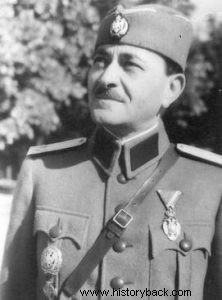
Musosky.
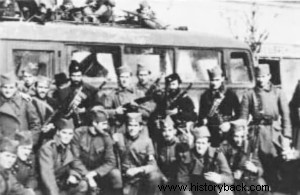
Men of the FTA together with Chetniks of Mihailovic.
